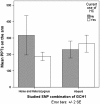GCH1-polymorphism and pain sensitivity among women with provoked vestibulodynia
- PMID: 22971341
- PMCID: PMC3489821
- DOI: 10.1186/1744-8069-8-68
GCH1-polymorphism and pain sensitivity among women with provoked vestibulodynia
Abstract
Background: Provoked vestibulodynia (PVD) is a pain disorder localized in the vestibular mucosa. It is the most common cause of dyspareunia among young women and it is associated with general pain hypersensitivity and other chronic pain conditions. Polymorphism in the guanosine triphosphate cyclohydrolase (GCH1) gene has been found to influence general pain sensitivity and the risk of developing a longstanding pain condition. The aim of this study was to investigate GCH1-polymorphism in women with PVD and healthy controls, in correlation to pain sensitivity.
Results: We found no correlation between the previously defined pain-protective GCH1-SNP combination and the diagnosis of PVD. Nor any correlation with pain sensitivity measured as pressure pain thresholds on the arm, leg and in the vestibule, coital pain scored on a visual analog scale and prevalence of other bodily pain conditions among women with PVD (n = 98) and healthy controls (n = 102). However, among patients with current treatment (n = 36), there was a significant interaction effect of GCH1-gene polymorphism and hormonal contraceptive (HC) therapy on coital pain (p = 0.04) as well as on pressure pain thresholds on the arm (p = 0.04). PVD patients carrying the specified SNP combination and using HCs had higher pain sensitivity compared to non-carriers. In non-HC-users, carriers had lower pain sensitivity.
Conclusions: The results of this study gave no support to the hypothesis that polymorphism in the GCH1-gene contributes to the etiology of PVD. However, among patients currently receiving treatment an interaction effect of the defined SNP combination and use of hormonal contraceptives on pain sensitivity was found. This finding offers a possible explanation to the clinically known fact that some PVD patients improve after cessation of hormonal contraceptives, indicating that PVD patients carrying the defined SNP combination of GCH1 would benefit from this intervention.
Figures


Similar articles
-
Serotonin receptor gene (5HT-2A) polymorphism is associated with provoked vestibulodynia and comorbid symptoms of pain.J Sex Med. 2014 Dec;11(12):3064-71. doi: 10.1111/jsm.12685. Epub 2014 Sep 1. J Sex Med. 2014. PMID: 25174699
-
A118G polymorphism in the μ-opioid receptor gene and levels of β-endorphin are associated with provoked vestibulodynia and pressure pain sensitivity.Scand J Pain. 2014 Jan 1;5(1):10-16. doi: 10.1016/j.sjpain.2013.10.004. Scand J Pain. 2014. PMID: 29913664
-
Reduced concentrations of vaginal metabolites involved in steroid hormone biosynthesis are associated with increased vulvar vestibular pain and vaginal muscle tenderness in provoked vestibulodynia: An exploratory metabolomics study.Mol Pain. 2021 Jan-Dec;17:17448069211041853. doi: 10.1177/17448069211041853. Mol Pain. 2021. PMID: 34505814 Free PMC article.
-
Clinical genetics of functionally mild non-coding GTP cyclohydrolase 1 (GCH1) polymorphisms modulating pain and cardiovascular risk.Mutat Res. 2008 Sep-Oct;659(3):195-201. doi: 10.1016/j.mrrev.2008.04.007. Epub 2008 Apr 26. Mutat Res. 2008. PMID: 18515178 Review.
-
The Relationship Between Vulvovaginal Candidiasis and Provoked Vulvodynia: A Systematic Review.J Sex Med. 2018 Sep;15(9):1310-1321. doi: 10.1016/j.jsxm.2018.07.011. Epub 2018 Aug 23. J Sex Med. 2018. PMID: 30145093
Cited by
-
Disruption of mitochondrial pyruvate oxidation in dorsal root ganglia drives persistent nociceptive sensitization and causes pervasive transcriptomic alterations.Pain. 2024 Jul 1;165(7):1531-1549. doi: 10.1097/j.pain.0000000000003158. Epub 2024 Jan 23. Pain. 2024. PMID: 38285538 Free PMC article.
-
Phenotypic drug screen uncovers the metabolic GCH1/BH4 pathway as key regulator of EGFR/KRAS-mediated neuropathic pain and lung cancer.Sci Transl Med. 2022 Aug 31;14(660):eabj1531. doi: 10.1126/scitranslmed.abj1531. Epub 2022 Aug 31. Sci Transl Med. 2022. PMID: 36044597 Free PMC article.
-
Genetic variants associated with development of TMD and its intermediate phenotypes: the genetic architecture of TMD in the OPPERA prospective cohort study.J Pain. 2013 Dec;14(12 Suppl):T91-101.e1-3. doi: 10.1016/j.jpain.2013.09.004. J Pain. 2013. PMID: 24275226 Free PMC article.
-
Pharmacogenetics of chronic pain and its treatment.Mediators Inflamm. 2013;2013:864319. doi: 10.1155/2013/864319. Epub 2013 May 20. Mediators Inflamm. 2013. PMID: 23766564 Free PMC article. Review.
-
Vulvodynia.Nat Rev Dis Primers. 2020 Apr 30;6(1):36. doi: 10.1038/s41572-020-0164-2. Nat Rev Dis Primers. 2020. PMID: 32355269 Review.
References
Publication types
MeSH terms
Substances
LinkOut - more resources
Full Text Sources

